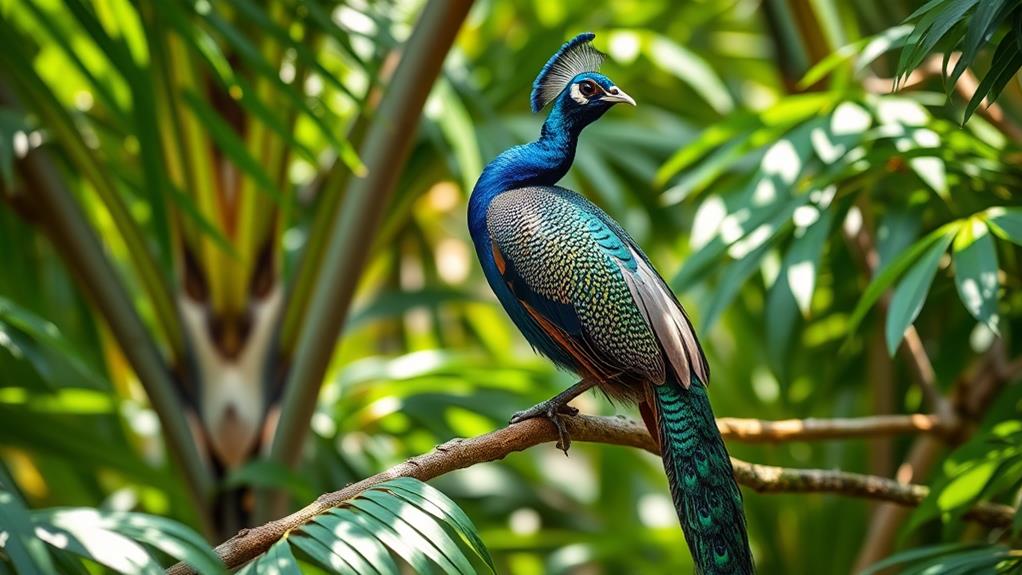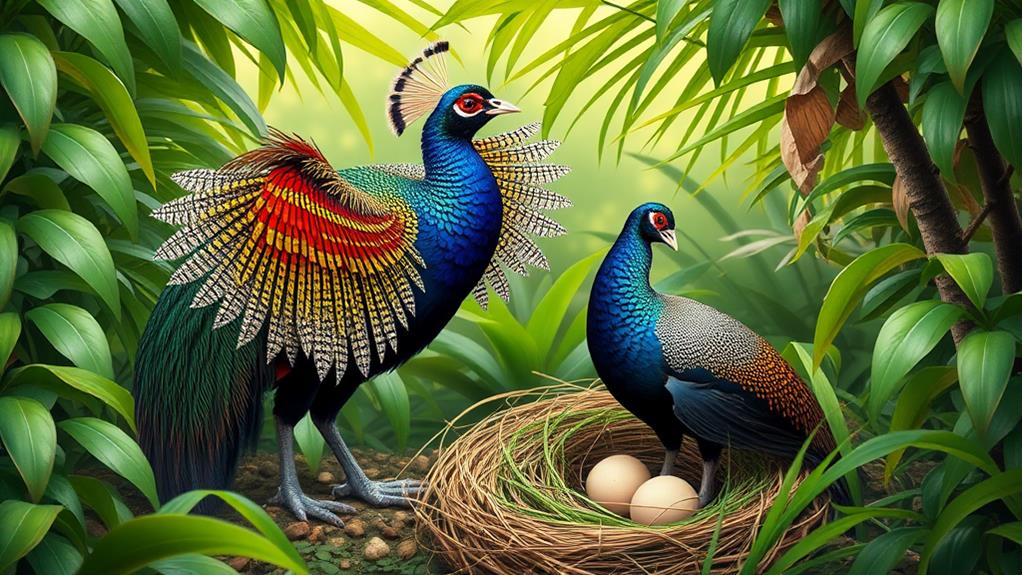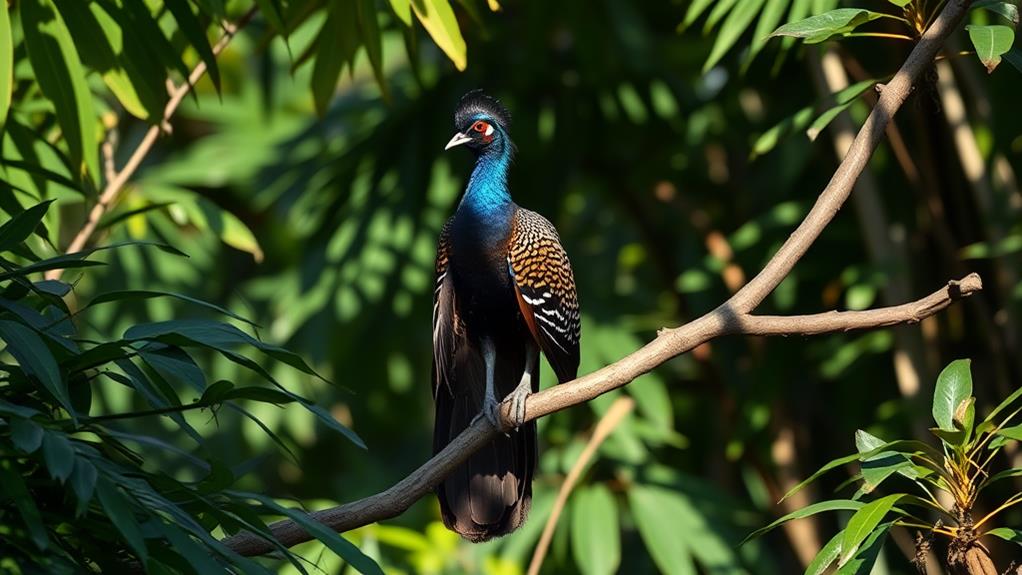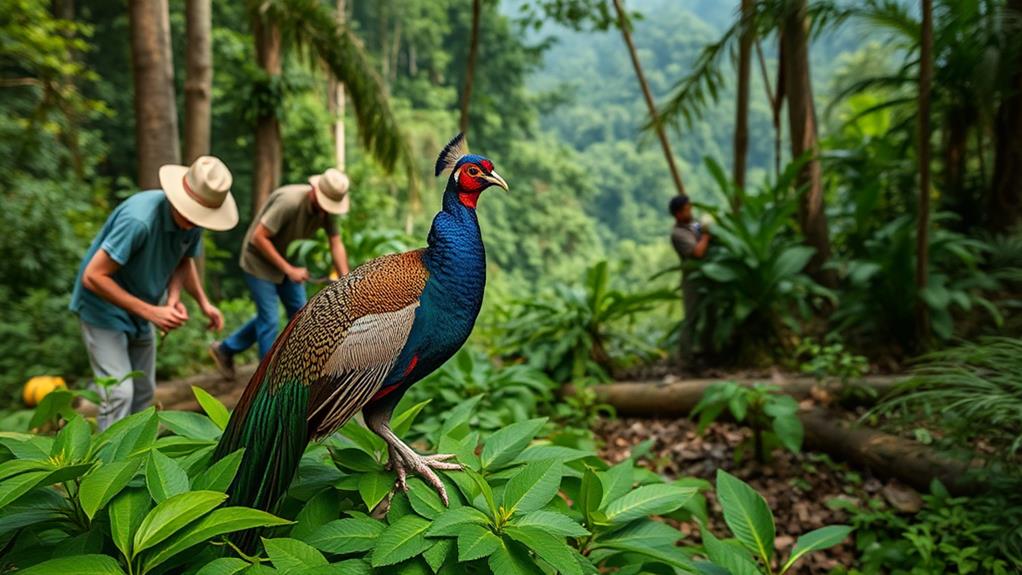The Palawan peacock-pheasant is a critically endangered bird species, with less than 50,000 individuals remaining. This bird plays a vital role in its ecosystem, and its population decline is mainly attributed to habitat loss due to deforestation. As a critically endangered bird, the Palawan peacock-pheasant faces a high risk of extinction in the wild. Efforts are being made to conserve and protect their remaining habitats, as well as to address the underlying causes of deforestation. Without urgent action, it is likely that the population of this critically endangered bird will continue to decline.
Additionally, hunting and illegal trade also pose significant threats to its survival.
The male Palawan peacock-pheasant is recognizable by its vivid colors, which contrast with the camouflaged females that help protect them from predators.
Conservation efforts are underway, with a focus on habitat restoration and legal protections. However, logging and mining activities continue to pose significant challenges to these efforts.
Understanding the importance of the Palawan peacock-pheasant and its habitat is crucial for wildlife preservation.
The struggle for survival of this species is a pressing concern, and exploring its conservation success stories can provide valuable insights into effective preservation strategies.
Overview of the Species

The Palawan peacock-pheasant is a unique bird species that plays a vital role in the ecosystem of Palawan Island's humid forests.
This species, scientifically known as *Polyplectron napoleonis*, is characterized by its striking coloration, with adult males displaying vibrant blue-violet and metallic green-turquoise plumage, while females have earthen colors for camouflage.
These adaptations are crucial for survival in their dense forest habitat, where they forage for invertebrates, seeds, and berries on the forest floor.
The Palawan peacock-pheasant is classified as an endangered species on the IUCN Red List due to significant threats to its survival. With fewer than 50,000 mature individuals remaining, the species faces habitat loss due to deforestation, hunting, and illegal capture for trade.
These factors not only put the species at risk but also disrupt the delicate balance of their ecosystem.
Conservation efforts are essential to ensure the survival of the Palawan peacock-pheasant. Habitat restoration, legal protections, and community engagement are crucial to mitigating threats and fostering awareness.
Protecting this species is vital for maintaining the health of the forests it inhabits.
Taxonomy and Classification
The Palawan Peacock-Pheasant's Classification
The Palawan peacock-pheasant, scientifically known as Polyplectron napoleonis, is a fascinating example of avian taxonomy.
Understanding its Classification
Understanding the classification of the Palawan peacock-pheasant is crucial for conservation efforts, as it highlights the complexity and diversity within the family Phasianidae, which includes pheasants and partridges.
Variations and Subspecies
Variations in male plumage have led to the identification of subspecies, including distinct forms adapted to their habitats. For example, the subspecies Polyplectron napoleonis has adapted to the Palawan habitat. Recognizing these variations enriches our understanding of the species' evolutionary strategies and ecological roles in Palawan.
Taxonomic Classification
The Palawan peacock-pheasant's classification is as follows:
| Taxonomic Rank | Classification |
|---|---|
| Kingdom | Animalia |
| Phylum | Chordata |
| Class | Aves |
| Family | Phasianidae |
Genetic Studies and Significance
Genetic studies reveal intricate relationships within the Phasianidae family, marking the Palawan peacock-pheasant as a significant subject for researchers aiming to unravel avian biodiversity. By grasping its taxonomy, we can appreciate the vital role this rare species plays in its ecosystem and the importance of preserving its habitat.
Geographic Distribution

Geographic Distribution of the Palawan Peacock-Pheasant
The Palawan peacock-pheasant is endemic to Palawan Island in the Philippines, with a unique geographic distribution that's critical for its conservation. This species is confined to humid forests and thrives at elevations below 1,000 meters (3,300 feet) above sea level, making its habitat narrowly defined.
The bird's population is distributed across approximately 20 localities on Palawan Island, although reports since 1980 suggest a potentially wider distribution than previously documented.
The population density is closely linked to large tree density, emphasizing its preference for primary and old-growth forests over secondary habitats.
With an estimated population of between 20,000 and 49,999 mature individuals, the Palawan peacock-pheasant primarily inhabits the forested areas of Palawan Island.
Any habitat loss or degradation poses a significant threat to the species, making it crucial to protect Palawan Island's rich ecosystems to maintain biodiversity in this unique region.
Preferred Habitat
The Palawan peacock-pheasant inhabits humid forests, where it relies on specific environmental conditions for survival. It thrives in primary and secondary forests, typically at elevations below 800 meters, particularly in old-growth forests that provide dense tree coverage necessary for safety and resources.
The species has a strong preference for mature ecosystems, as they provide the necessary resources for foraging and nesting. The population density of the Palawan peacock-pheasant positively correlates with large tree density, indicating that the presence of mature trees is vital for its survival.
The bird avoids cultivated areas, relying solely on undisturbed habitats.
Habitat destruction poses a significant threat to its existence, as forests are logged or converted for agriculture, diminishing the availability of its preferred habitat.
Preserving humid forests is crucial for the Palawan peacock-pheasant's survival, as it's essential for maintaining biodiversity in the region.
Diet and Feeding Habits

The Palawan peacock-pheasant's diet is omnivorous, consisting of invertebrates, small frogs, seeds, and berries. This diverse diet allows the species to adapt to the rich resources found within its humid forest habitat.
For example, they forage on the forest floor to search for insects, fruits, worms, and slugs hidden among the undergrowth.
Seasonal availability of food influences their dietary choices. The species varies its intake depending on the time of year and local resource abundance. This adaptability is critical for their survival, particularly in a changing environment where food sources may fluctuate.
The Palawan peacock-pheasant's feeding habits contribute to ecosystem balance. By aiding in seed dispersal and controlling invertebrate populations, they significantly contribute to the health of their habitat.
For instance, their ground-dwelling behavior enables them to forage effectively while minimizing exposure to predators.
Conserving the Palawan peacock-pheasant's habitat and ensuring abundant food resources are crucial. Understanding the diet of this remarkable and endangered species highlights the importance of preserving its habitat to ensure its survival.
Behavior and Social Structure
Palawan peacock-pheasants have a unique social structure that plays a vital role in their survival. These birds are strictly monogamous, forming long-term bonds with their partners and working together to raise their chicks for up to two years. This joint effort increases the chances of their offspring's survival, as both parents are actively involved in nesting and nurturing.
During courtship, males use a behavior called tidbitting to attract females. They display their vibrant neck feathers and offer food while making distinctive vocalizations, characterized by short high screeches repeated every five seconds. This visual and auditory display helps establish dominance and attract mates.
Palawan peacock-pheasants primarily forage on the forest floor, highlighting their ground-dwelling behavior. This behavior emphasizes the importance of their habitat in supporting their lifestyle.
Understanding these intricate behaviors and social structures is crucial for appreciating the delicate balance required for their survival and the need for conservation efforts to protect these rare birds and their environment.
Reproductive Cycle

The Palawan Peacock-Pheasant's Reproductive Cycle
The Palawan peacock-pheasant's reproductive cycle is characterized by lifelong monogamous relationships between pairs, which significantly enhances their reproductive success.
During the breeding season, males engage in aggressive and vocal displays to attract females. These displays often involve short high screeches and tidbitting, where they showcase their neck feathers and offer tidbits of food.
Once a pair has formed, the female typically lays up to two eggs, which she incubates for about 24 days.
After hatching, both parents cooperate to care for their chicks, nurturing them for up to two years. This collaborative care is crucial in protecting the young from predators and ensuring they receive adequate food.
Key aspects of their reproductive cycle include:
- Lifelong monogamous pairs
- Females laying a maximum of two eggs
- Males engaging in courtship through tidbitting, showcasing neck feathers and offering tidbits of food
- Cooperative care from both parents for up to two years
Understanding this reproductive cycle highlights the importance of their strong bond and teamwork, which is crucial for the survival of this rare and endangered species.
Conservation Status
Conservation Status of the Palawan Peacock-Pheasant
The Palawan peacock-pheasant, a stunning bird, faces significant threats to its survival. Currently classified as Vulnerable on the IUCN Red List, its population has rapidly declined due to habitat destruction and pressures from hunting and capture. Only between 20,000 and 49,999 mature individuals are left, a stark warning of its precarious status.
International Protections
The Palawan peacock-pheasant is listed on CITES Appendix I, which prohibits international trade to prevent further declines. However, enforcement remains a challenge, particularly in areas affected by logging and mining activities that encroach on its endemic habitat on Palawan Island.
Conservation Efforts
Protected areas like El Nido Marine Reserve and Puerto Princesa Subterranean River National Park have been established. These areas provide a safe habitat for the Palawan peacock-pheasant.
However, active engagement from local communities and environmental awareness campaigns are essential to ensure the long-term survival of this bird. By fostering local stewardship, threats can be mitigated and efforts to secure its future can be supported.
Threats to Survival

The Palawan peacock-pheasant's survival is threatened by various human activities and habitat destruction. Deforestation is a significant threat, with logging rates reaching 11% between 2000 and 2005, resulting in the loss of habitat.
Habitat destruction is further exacerbated by extensive logging and mining concessions that now cover nearly all remaining forest areas on Palawan Island. For instance, illegal logging continues to occur in southern forest regions, compromising the stability of the Palawan peacock-pheasant's habitat.
Illegal activities undermine conservation efforts, and hunting pressures around protected areas increase the vulnerability of this species.
Additionally, climate change alters habitats and leads to resource competition from invasive species, further threatening the Palawan peacock-pheasant's existence.
Immediate action is necessary to protect this unique bird and preserve our natural heritage. If we fail to act, we risk losing not just a species, but a vital part of our ecosystem.
Related Species
The Palawan peacock-pheasant is not an isolated species. It shares its habitat with several closely related species within the *Polyplectron* genus and the broader Phasianidae family. One such species is *Polyplectron bicalcaratum*, which exhibits similar vibrant plumage and behaviors, showcasing their shared evolutionary traits.
Genetic studies reveal complex relationships among these species, highlighting their unique adaptations and ecological roles. For instance, the avian community in Palawan is enriched by partridge species such as *Arborophila ardens* and *Alectoris chukar*, which coexist with the Palawan peacock-pheasant.
Conservation efforts targeting the Palawan peacock-pheasant benefit related species. Habitat preservation enhances biodiversity, and the following species are also protected:
| Species Name | Conservation Status | Habitat Type |
|---|---|---|
| Palawan peacock-pheasant | Endangered | Humid forests |
| Polyplectron bicalcaratum | Near Threatened | Tropical rainforests |
| Arborophila ardens | Vulnerable | Forested hills |
Preserving habitats is vital for the survival of these species, as it enhances biodiversity and supports the coexistence of species on the List of Threatened Species.
Conservation Efforts

Conservation Efforts for the Palawan Peacock-Pheasant
The Palawan peacock-pheasant, classified as Vulnerable on the IUCN Red List, urgently needs conservation efforts to combat habitat loss and hunting pressures.
Between 2000 and 2005, an alarming 11% deforestation rate was recorded, threatening its survival.
To address these challenges, several strategic conservation efforts are underway:
Habitat Restoration: Initiatives aim to recover and protect critical areas. For example, restoring forests and grasslands helps to provide a suitable habitat for the Palawan peacock-pheasant.
Legal Protections: The species is listed on CITES Appendix I, and legal protections are enforced to prevent illegal trade and hunting.
Stricter hunting controls are proposed to combat illegal activities.
Local Community Collaboration: Collaborating with local communities fosters awareness and reduces hunting pressures. By engaging with local communities, we can educate them on the importance of conservation and encourage their involvement in protecting the species.
Biosphere Reserve: The establishment of Palawan as a Biosphere Reserve in 1990 marked progress, but enforcement challenges remain.
It's crucial to support these conservation efforts to ensure the future of the Palawan peacock-pheasant.
By prioritizing habitat protection and engaging with local communities, we can create a sustainable environment for this rare bird and preserve its natural habitat for generations to come.
Questions and Answers
Is Palawan Peacock-Pheasant Endangered?
The Palawan peacock-pheasant is considered endangered. This is primarily due to significant habitat loss resulting from ongoing deforestation, driven by logging and agricultural expansion.
These human activities severely threaten the species' population.
Conservation efforts are crucial to protect this species. Engaging local communities in protective initiatives can foster awareness and support for habitat preservation, ensuring the Palawan peacock-pheasant can thrive in its natural environment for future generations.
Why Is the Palawan Peacock-Pheasant Important?
The Palawan peacock-pheasant plays a crucial role in preserving the unique ecosystems of Palawan. By protecting this bird and its habitat, we're also safeguarding the diverse wildlife that depends on these ecosystems.
For example, the peacock-pheasant's habitat supports a wide range of plant and animal species found only in Palawan.
The Palawan peacock-pheasant is a cultural symbol of the island's rich heritage. It connects local communities with their environment and represents a healthy habitat, indicating ecological balance.
By conserving the peacock-pheasant, we're preserving both biodiversity and cultural identity, which is essential for future generations.
What Is the Rarest Pheasant in the World?
The White-Eared Pheasant is the rarest pheasant in the world, threatened by habitat loss and declining populations. Conservation efforts are crucial for its survival, as protecting its habitat helps maintain the delicate ecosystem it relies on.
For instance, the White-Eared Pheasant inhabits the mountainous forests of Southeast Asia, where deforestation and agriculture have led to habitat loss. Supporting initiatives that restore these environments not only benefits the pheasant but also promotes biodiversity.
For example, conservation efforts in Myanmar's Shan State have helped to restore habitats and increase the pheasant's population. By advocating for these conservation measures, you can play a vital role in preserving this unique species and ensuring its future.
What Is the Trivia of Palawan Peacock-Pheasant?
The Palawan peacock-pheasant is a strictly monogamous species, with pairs forming during breeding season and staying together for up to two years.
Both parents take turns incubating eggs and caring for their chicks during this period.
The birds thrive in dense forests with rich vegetation, which provides them with the necessary food and shelter.
They're particularly drawn to areas with dense undergrowth and abundant plant life.
The Palawan peacock-pheasant's courtship displays are striking and unique, involving a behavior called tidbitting.
During tidbitting, the male bird presents the female with food, such as fruits or insects, while performing an elaborate dance.
This display increases the male's chances of attracting a mate and securing a successful breeding season.
Conservation efforts are crucial to protect the Palawan peacock-pheasant's unique habitat, which is essential for the species' survival.